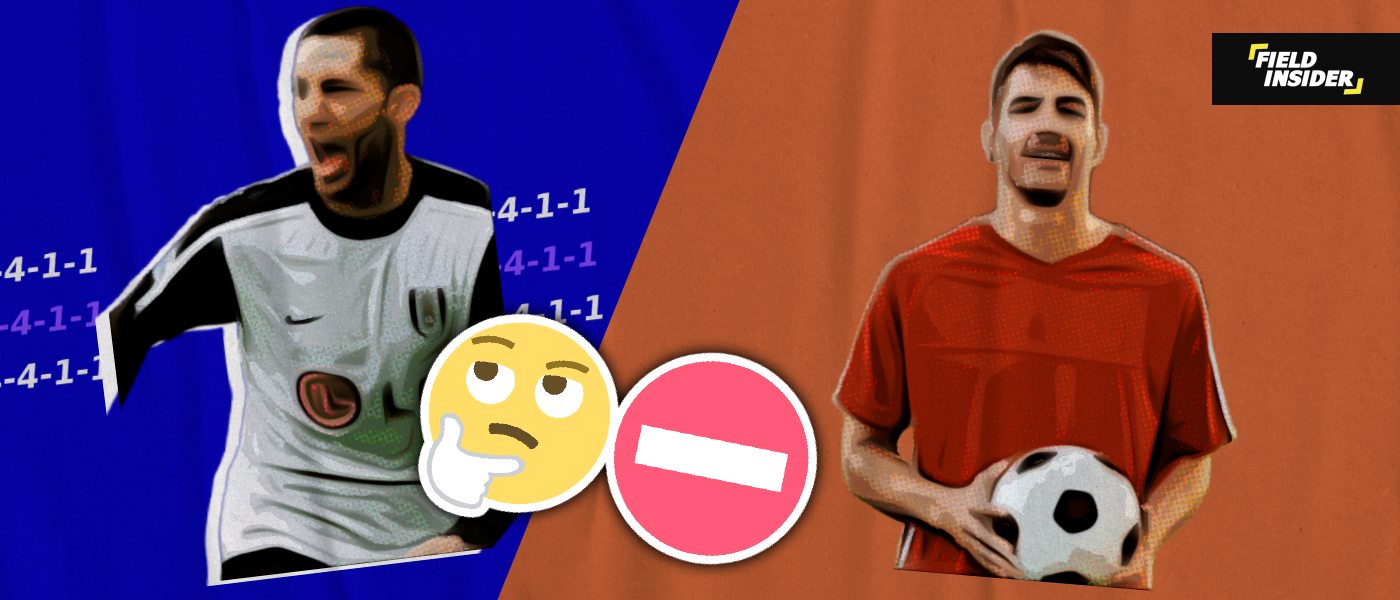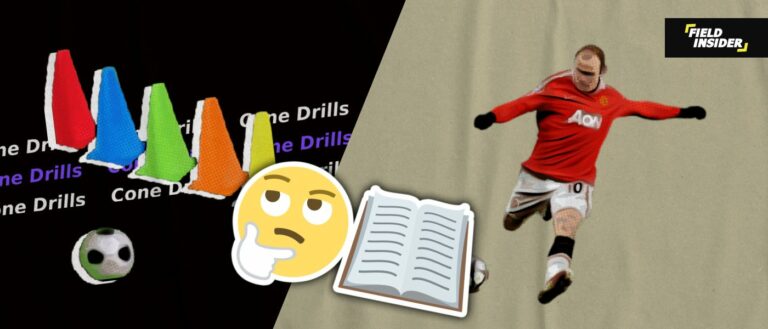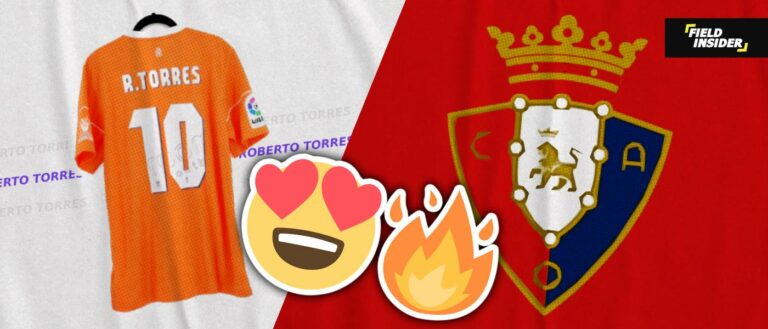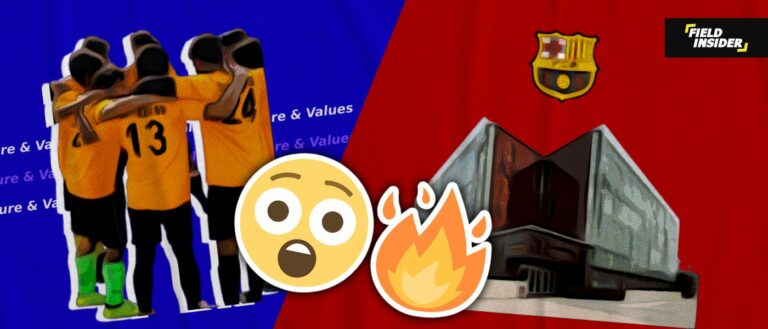The 4-4-1-1 Formation: Complete Handbook
The 4-4-1-1 formation is a versatile tactical setup in soccer that expertly balances defense and attack. By understanding its structure and strategic nuances, teams can leverage this formation to optimize their gameplay.
This guide delves into the formation’s defensive and offensive roles, offering insights into its strengths, weaknesses, and tactical flexibility. Coaches and players can benefit from exploring how the 4-4-1-1 can be tailored to their team’s specific strengths and game situations.
Key Takeaways
| Key Takeaways | Details |
|---|---|
| Defensive Stability | Provides a solid defensive backbone with a well-structured backline. |
| Flexibility in Attack | Offers multiple attacking options through dynamic roles in midfield and attack. |
| Positional Discipline | Requires strict adherence to assigned roles, crucial for maintaining formation integrity. |
| Tactical Adaptability | Easily adaptable to counter various opponent tactics and match scenarios. |
Formation Breakdown

Defensive Structure
The 4-4-1-1 formation prioritizes a strong defensive foundation, essential for reducing the opponent’s scoring opportunities. It features a four-man backline that acts as the first line of defense against attacking threats.
This layer is instrumental in shutting down opposing forwards and maintaining a clean sheet.
Roles and Responsibilities
In the 4-4-1-1 setup, the central defenders focus primarily on neutralizing the main attacker, excelling in aerial duels and crucial tackles.
The full-backs contribute both defensively and offensively, managing threats from the wings while also providing support in forward runs. Their cohesive performance is crucial for the team’s overall defensive stability.
Defensive Strategies
The formation emphasizes a compact and disciplined defensive structure, especially under pressure. Maintaining close distances between players helps in covering spaces and blocking key passing lanes.
This strategy is effective in containing the opposition and preventing them from finding rhythm in their play.
Midfield Organization

The midfield in the 4-4-1-1 acts as the core of both defense and attack, facilitating smooth transitions between the two phases.
It consists of four midfielders who control the center of the park, crucial for dictating the pace and direction of the game.
Central and Wide Midfielders’ Roles
The central midfielders are the pivot points for both defense and attack, tasked with distributing the ball and breaking up opposition plays.
Wide midfielders need to balance their roles carefully; they must provide width in attack and support the full-backs defensively. Their dynamic roles are vital for the team’s adaptability and width on the pitch.
Creating Passing Lanes
Effective midfield play involves creating and exploiting passing lanes, which are essential for penetrating the opponent’s defensive setup.
This requires intelligent positioning and movement from the midfielders, aiming to stretch the opposition and open up spaces for forward progression. These tactics enhance ball retention and facilitate controlled offensive build-up.
Attacking Dynamics
At the heart of the 4-4-1-1’s offensive efforts are the attacking midfielder and the lone striker, who together create the main attacking threat. This duo is designed to adapt quickly to different defensive arrangements they face, making the formation versatile in its approach to goal scoring.
Roles of the Attacking Midfielder and Lone Striker
The attacking midfielder links the midfield to the attack, orchestrating plays and providing key passes to the striker.
Positioned just behind the lone striker, this player is crucial for creating scoring opportunities through vision and creativity. The striker’s role is to capitalize on these chances, using their positioning and finishing skills to score.
Transitioning from Defense to Attack
Transitioning swiftly from defense to attack is a hallmark of the 4-4-1-1 formation. The team must quickly move the ball forward after regaining possession, exploiting the temporary disorganization in the opponent’s setup.
The attacking midfielder plays a pivotal role in these transitions, often initiating fast breaks and directing the attack towards goal.
Advantages and Disadvantages
Strengths of the 4-4-1-1 Formation
The 4-4-1-1 formation offers several distinct advantages that can be leveraged to control the game and secure positive outcomes. Its design promotes both defensive solidity and attacking flexibility.
Defensive Solidity
One of the primary strengths of the 4-4-1-1 is its robust defensive structure. With four defenders lined up across the back and a midfield quartet providing additional support, the team is well-equipped to handle various attacking threats.
This setup minimizes gaps and reduces the opponent’s chances of penetrating the defensive line.
Flexibility in Attack
Despite its strong defensive orientation, the 4-4-1-1 also excels in offering various attacking options. The presence of an advanced midfielder behind the lone striker allows the team to adapt their offensive tactics based on the situation at hand.
This position can pivot between creating chances and joining the striker to form a dual threat, enhancing the formation’s adaptability.
Weaknesses and Potential Vulnerabilities

While the 4-4-1-1 formation is strategically sound, it does have certain weaknesses that teams must manage to avoid exploitation by opponents. Recognizing and addressing these vulnerabilities is key to maintaining the effectiveness of the formation.
Vulnerability on the Flanks
The formation’s emphasis on a compact central setup can sometimes leave the flanks less protected, especially if the wide midfielders are drawn inward or fail to track back.
This can be particularly problematic against teams that employ strong wing play or use wide areas to stretch the defense. Ensuring that wide midfielders fulfill their defensive roles is critical to mitigating this risk.
Need for Disciplined Positioning
The effectiveness of the 4-4-1-1 heavily relies on disciplined positioning from all players. If individuals stray too far from their assigned roles, it can create spaces for the opposition to exploit.
This discipline is especially crucial during transitions and when adjusting to the flow of the game. Maintaining structured movement and awareness of positional responsibilities is essential for this formation to succeed.
Key Strategies and Adjustments
Adjustments for Different Match Scenarios
The 4-4-1-1 formation is highly adaptable, allowing coaches to make strategic adjustments based on the state of the game. These modifications can help in maintaining control when leading or intensifying attacks when chasing.
Holding a Lead
When in the lead, the formation can be tweaked to emphasize defense without completely relinquishing attacking intent.
The central midfielders can drop slightly deeper, reinforcing the defensive line, while the attacking midfielder can focus more on ball retention than riskier forward thrusts. This conservative shift helps in managing the game’s pace and preserving the lead.
Chasing a Goal
Conversely, when needing to score, the formation can transform to increase offensive pressure. Pushing the full-backs up provides additional width and crossing opportunities, and the midfield can adopt a more aggressive posture.
Allowing the attacking midfielder greater freedom to roam and create can inject unpredictability and dynamism into the attack.
Counteracting Opponent Formations
Adapting the 4-4-1-1 to effectively counter opponent strategies can significantly influence the game’s outcome.
Understanding and anticipating the opponent’s tactics allows for preemptive adjustments that can neutralize their strengths and exploit their weaknesses.
Breaking Down a Compact Defense
Facing a compact defensive setup requires strategic creativity. Utilizing the wide areas more effectively and increasing the tempo of passing can help in stretching the defense and opening gaps.
Encouraging the attacking midfielder to find and exploit these spaces can lead to critical scoring opportunities.
Dealing with High-Pressing Teams
When up against high-pressing opponents, quick and precise long balls can bypass the press, exploiting the space behind the advancing defenders. Training players to maintain composure and execute accurate long-range passes under pressure is key.
Additionally, reinforcing support for the striker by bringing the attacking midfielder closer can help in retaining possession in advanced areas.
Successful Implementations in Professional Soccer
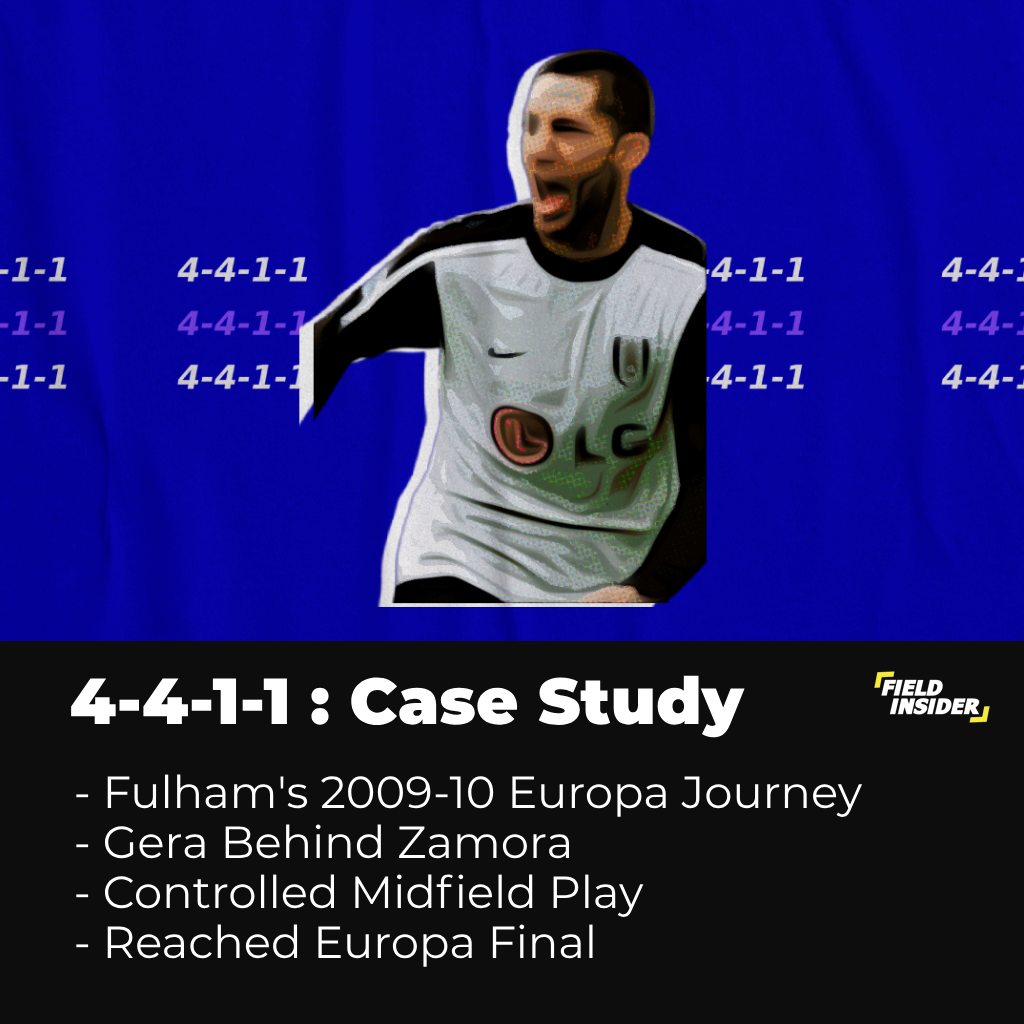
The 4-4-1-1 formation has been effectively utilized by several professional soccer teams, demonstrating its adaptability and strategic depth in competitive settings. One of the most notable implementations occurred during the 2009-10 season with Fulham FC in the English Premier League.
Fulham’s 2009-10 Europa League Journey
Fulham’s remarkable run to the UEFA Europa League final in the 2009-10 season is a prime example of the 4-4-1-1 formation’s potential when executed well. Under the management of Roy Hodgson, Fulham adopted the 4-4-1-1, which perfectly suited their squad.
Zoltan Gera, playing just behind the striker Bobby Zamora, became a key figure in this setup. Gera’s role was pivotal, acting as both a creator and a secondary striker, which added a dynamic layer to Fulham’s attack.
Tactical Analysis of Fulham’s 2009-10 Season
Throughout the Europa League campaign, Fulham’s approach allowed them to control games through a compact midfield and a disciplined defensive line, while Gera and Zamora provided the necessary offensive thrust.
Their ability to switch from defense to attack seamlessly was crucial in their European success, culminating in a narrow 2-1 defeat in extra time during the final. This journey not only highlighted the effectiveness of the 4-4-1-1 but also showcased how well it can perform against top European competition.
Practical Tips for Coaches and Players
Implementing the 4-4-1-1 formation effectively requires thorough understanding and practice. Coaches and players can benefit from focused training drills and clear guidance on individual roles within this setup.
Training Drills to Optimize Performance in the 4-4-1-1
| Area of Focus | Training Drill | Objective |
|---|---|---|
| Defensive Coordination | Defensive shape exercises | Enhance defenders’ ability to maintain formation integrity and spatial awareness. |
| Midfield Control | Possession and passing drills | Improve midfielders’ capability to control tempo and create passing lanes. |
| Attacking Synergy | Combination play between striker and AM | Develop the relationship and effectiveness of the attacking midfielder and striker in creating scoring opportunities. |
| Transitional Play | Fast break simulations | Train quick transitions from defense to attack, exploiting the opponent’s disorganization. |
| Positional Discipline | Role-specific scenario games | Ensure each player understands and executes their tactical role under different game conditions. |
Individual Player Roles and Responsibilities
Clear communication of individual roles and responsibilities is crucial for the successful implementation of the 4-4-1-1 formation. Each player must understand their specific duties and how they fit into the team’s broader tactical plan.
Enhancing Understanding of Roles
Coaches should hold individual and group sessions to discuss the nuances of each position within the 4-4-1-1 setup.
For instance, the central midfielders need to know when to drop back to defend and when to push forward to support the attack. Similarly, the attacking midfielder should be skilled at finding gaps in the opposition’s defense and linking up play with the striker.
Goalkeeper’s Role: A Comparison Between Formations
The adjacent chart, derived from the research titled “Defending in 4-4-2 or 5-3-2 formation? Small differences in footballers’ collective tactical behaviours,” showcases the comparative number of passes made by a goalkeeper in two formations.

In the 4-4-2 formation, goalkeepers tend to make more passes than in the 5-3-2 setup. This is noteworthy, considering the 4-4-1-1 formation, the focal point of our article, is an evolution of the 4-4-2 and maintains many of its passing structures.
The findings underscore the significance of the goalkeeper as a play initiator, even more so in the 4-4-2 and by extension, its close relative, the 4-4-1-1. These insights help us understand how a goalkeeper’s distribution contributes to the fluidity and dynamism of the team’s overall play.
Conclusion
In conclusion, mastering the 4-4-1-1 formation can significantly enhance a team’s performance by balancing defensive solidity with attacking flexibility. This formation requires disciplined positioning and tactical adaptability.
Through detailed breakdowns, strategic adjustments, and practical training tips, teams can harness the full potential of the 4-4-1-1 to achieve success on the soccer field. Coaches and players are encouraged to continually explore and implement this formation to stay competitive.


